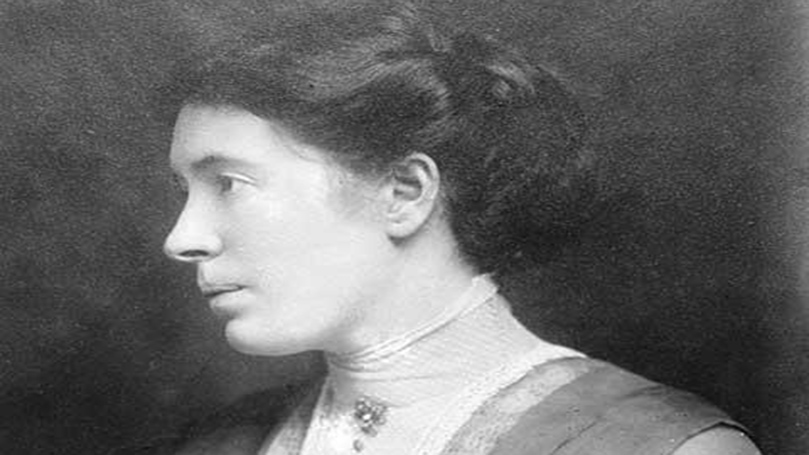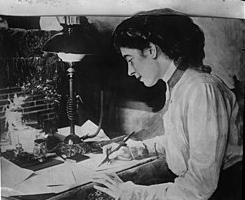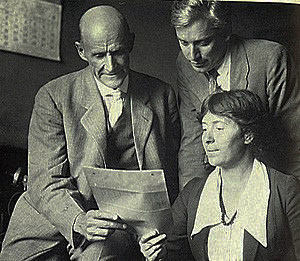
Can romance transcend class? The answer, based on Adam Hochschild’s latest book Rebel Cinderella (Houghton Mifflin Harcourt, 2020), seems to be yes . . . for a while.
Hochschild, author of King Leopold’s Ghost and Spain in Our Hearts, tells the life story of Rose Pastor Stokes, a Jewish woman born into poverty in 1879 in Czarist Russia. Her Yiddish name was Raisel Wieslander. Her short life comprises two stories—a rags-to-riches Cinderella story and a story of a tireless, inspired, dedicated, intelligent, creative, and passionate communist and champion of the working class who helped found the Communist Party in 1919.
Rose immigrated to America in 1903 and began to toil in cigar sweatshops at age 11. With only two years of formal schooling, she empowered herself through class consciousness and became a union organizer, poet, and writer for the Jewish Daily News and later the New York Call, a Socialist Party daily.
The criminalization of birth control was an outrage to her, having grown up with six siblings who often did not have enough to eat. The Comstock Act of 1873, supposedly targeting obscenity, made the promotion of contraception a federal crime. A charismatic and talented orator, Rose did just that, giving fiery speeches in favor of birth control for the working class and risking imprisonment.
She volunteered at settlement houses, which were community gathering places where educated or well-to-do liberal reformers could have “vital contact” with the poor. The theory behind these institutions was that class struggle, abolition of capitalism, and redistribution of wealth were not needed and could be avoided if only the poor and immigrants were given basic instruction in life skills such as cooking and hygiene. Years later, she would denounce settlement houses and other philanthropic reforms as counter-revolutionary.
 The Cinderella story began on a Friday in 1903, when Rose, at age 24, visited University Settlement House on the Lower East Side while on assignment for the Jewish Daily News. There she met a bourgeois, wealthy reformer named James Graham Phelps Stokes. She rightly regarded him as being from “a totally foreign universe.” His family owned a 100-room mansion, at that time the largest private dwelling in the United States. There was a spark between them, and they married in 1905. She insisted that the word “obey” be eliminated from the service. Just a week before she met Graham, Rose had cautioned poor and working-class girls about romantic Cinderella stories in her column for the Jewish Daily News: “What excuse is there other than ignorance for any girl who reads such crazy fantasies . . . if you read those books—stop! stop!”
The Cinderella story began on a Friday in 1903, when Rose, at age 24, visited University Settlement House on the Lower East Side while on assignment for the Jewish Daily News. There she met a bourgeois, wealthy reformer named James Graham Phelps Stokes. She rightly regarded him as being from “a totally foreign universe.” His family owned a 100-room mansion, at that time the largest private dwelling in the United States. There was a spark between them, and they married in 1905. She insisted that the word “obey” be eliminated from the service. Just a week before she met Graham, Rose had cautioned poor and working-class girls about romantic Cinderella stories in her column for the Jewish Daily News: “What excuse is there other than ignorance for any girl who reads such crazy fantasies . . . if you read those books—stop! stop!”
When she and Graham married, the press went crazy. Hochschild writes that “her name was mentioned more often in the press than that of any other woman in the United States.” The press breathlessly asked: Would she be corrupted by his wealth? Would she be rejected by his family? Would she abandon her class consciousness?
But Rose was modest and humble with tremendous integrity. Her devotion to communism and the working class never weakened, and her class consciousness grew stronger. Her stand on racism reveals how she was much more enlightened than her husband. She had joined the Intercollegiate Socialist Society (ISS) with Upton Sinclair, author of The Jungle. While speaking for the ISS in the South, she encountered segregation and resisted. Graham was then president of the ISS but, as a reactionary in the face of racism, he ruled that setting up black ISS chapters “would set back the socialist cause for many years.”
Rose and Graham joined the Socialist Party, and Rose campaigned for Eugene V. Debs for president. She worked with the Industrial Workers of the World (IWW). She joined Heterodoxy, a discussion group for unorthodox, progressive, and enlightened women including Elizabeth Gurley Flynn. Her desire to abolish capitalism was further strengthened by the carnage (146 dead) of the Triangle Shirtwaist Company fire of March 25, 1911. She helped John Reed, author of Ten Days That Shook the World, to stage the 1913 pageant in support of striking Paterson, New Jersey, silk workers. She worked with Max Eastman, editor of The Masses, and traveled to Russia with him in 1922 as a U.S. delegate to the Comintern or Communist International.
 At first Rose and Graham worked together to champion the liberation of the working class, often sharing a stage for speaking engagements until he could no longer stand in her light. The New York Tribune declared that “her fiery words were greeted with cheers from socialists, anarchists, and plain workers alike.” She so moved a crowd that “men wept,” according to an entry in her diary following one talk. Their friends included Emma Goldman, Dorothy Day, and Mabel Dodge Luhan, famed for making her 5th Avenue home into a meeting place for Wobblies, writers, artists, bohemians, feminists, and poets so that “her salons burst upon New York like a rocket.” Graham called Rose “Girlie.” Their love seemed secure, even though Emma Goldman warned that “marriage is to love as capitalism is to labor.”
At first Rose and Graham worked together to champion the liberation of the working class, often sharing a stage for speaking engagements until he could no longer stand in her light. The New York Tribune declared that “her fiery words were greeted with cheers from socialists, anarchists, and plain workers alike.” She so moved a crowd that “men wept,” according to an entry in her diary following one talk. Their friends included Emma Goldman, Dorothy Day, and Mabel Dodge Luhan, famed for making her 5th Avenue home into a meeting place for Wobblies, writers, artists, bohemians, feminists, and poets so that “her salons burst upon New York like a rocket.” Graham called Rose “Girlie.” Their love seemed secure, even though Emma Goldman warned that “marriage is to love as capitalism is to labor.”
Then, with the arrival of World War I, military madness gripped the country, infecting even some socialists. Graham joined the New York National Guard and, as Upton Sinclair observed, “began drilling in one of the New York armories, preparing to kill any of his former comrades who might attempt an uprising.” Graham wrote countless letters to the State Department snitching on persons he said were German agents. Vigilante groups such as the American Protective League began breaking up left-wing or antiwar meetings. In the name of patriotism, labor unions came under attack. War, as a measure of masculine virility, meant that outspoken antiwar or pacifist women were especially despised. President Woodrow Wilson called Rose “one of the most dangerous influences of the country.”
Graham complained that Rose, while on her lecture circuit, “was staying away so long.” In 1918 she was arrested and jailed in Missouri for speaking against the war: “No government which is for the profiteers can be also for the people, and I am for the people, while the government is for the profiteers.” She saw through Wilson’s claim that it was a war to make the world safe for democracy—and knew it was all about making the world safe for capital. While she awaited sentencing for denouncing a war that killed 9 million soldiers, Graham was in New York marching with his national guard unit. Rose was given ten years, but her case was successfully appealed and dismissed in 1920. She was arrested again that same year, this time for sedition. That charge too was eventually dismissed.
“The strain between the couple was now visible to everyone.”
Hochschild writes, “The strain between the couple was now visible to everyone.” Graham abandoned socialism, but Rose became inspired by the Russian Revolution of 1917 and held to her firm belief in working-class revolution. Infiltrators and provocateurs caused great tensions within the Left, and Rose’s marriage added to that tension among her comrades. Divorce seemed out of reach, since New York law granted divorce only on grounds of adultery. Still, “Rose found it increasingly difficult to remain in the same house as Graham,” and they were finally divorced in 1925.
Rose’s rags-to-riches story, more accurately, is a rags-to-riches-to-rags story. Divorced at age 45, she had almost no income and no real means of support: “She sometimes went hungry . . . [and] owed money to the grocer.” A newspaper headline read, “Once Rich ‘Ghetto Rose’ Now Reported Destitute.” She landed a secretarial job at a small Communist Party–connected relief agency.
What stands out in this Cinderella story is this great woman’s integrity, fidelity to her political cause, and rock-solid class consciousness. Her faith in communism never waivered, and she remained a Party member until her death in 1933 at age 54. After Emma Goldman published My Disillusionment in Russia, Rose criticized her old friend for having “turned away from the light.” She titled her own memoir I Belong to the Working Class.
Graham’s My Narrative, his 266-page, never published memoir, does not once mention Rose, an omission that suggests his very desperate attempt to step out from her shadow. Hochschild concludes that “what most upset him may have been that the woman who began as someone worshiping his superior knowledge turned out, in the end, to be assertive, independent, and unwilling to bend her life’s course to his.” Her marriage into great wealth failed to alter her proud socialist identity. She remains forever an authentic comrade.
Hochschild is a talented writer, combining the personal with the political. The personal story celebrates a lovely young communist woman who could not be corrupted by wealth. The political story documents a reactionary America, belligerent with anticommunist hysteria, committed to the exploitation of labor, and driven by nationalist rhetoric to eagerly embrace the bloodletting of World War I. A melding of romance and history, Rebel Cinderella succeeds in telling both of these important stories.
Cover image: Wikimedia Commons (no known restrictions).
Images: Rose Pastor Stokes; Eugene Debs, Max Eastman, and Stokes; Wikipedia.


 Join Now
Join Now